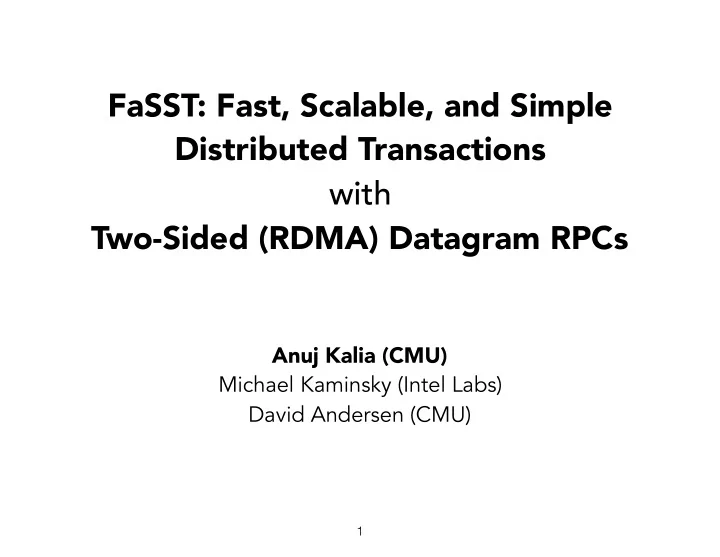

FaSST: Fast, Scalable, and Simple Distributed Transactions with Two-Sided (RDMA) Datagram RPCs Anuj Kalia (CMU) Michael Kaminsky (Intel Labs) David Andersen (CMU) 1
One-slide summary Node 1 Node 2 One-sided (READ) NIC Two-sided (SEND) RECV DRAM CPU Existing systems FaSST • Uses RPCs over two-sided ops Use one-sided RDMA (READs and WRITEs) for • ~2x faster than existing systems transactions • F ast, s calable, s imple 2
In-memory distributed transactions Distributed ACID transactions can be fast in datacenters FaRM [SOSP 15, NSDI 14] , DrTM [SOSP 15, EuroSys 15] , RSI [VLDB 16] Enablers: 1. Cheap DRAM, NVRAM : No slow components on critical path 2. Fast networks : Low communication overhead 3
Transaction environment y ‘ x ‘ x y x Node 1 Node 2 Node 3 Node N Hash table How to access remote data structures? Existing systems FaSST Method One-sided READs Two-sided RPCs Round trips ≧ 2 1 Node 1 READ READ RPC request RPC response (pointer) (value) Node 2 4
RPC v/s READs microbenchmark Experiment: Fetch 32-byte chunks with READs, or RPCs FaSST RPCs make transactions faster READs GETs/s (2 READs) RPCs FaRM [SOSP 15, Fig 2] FaSST (2x ConnectX-3 NICs) (1x Connect-IB NIC) 20 60 18.0 NIC-limited Tput/machine (M/s) Tput/machine (M/s) 49.2 15 45 40.9 10 30 9.0 24.6 CPU-limited 5 4.4 15 0 0 READs GETs/s (2 READs) RPCs READs Effective GETs/s w/ READs RPCs O(1,0) tput O(1,0) tput 5
Reasons for slow RPCS Existing systems FaSST Method One-sided READs Two-sided RPCs Round trips ≧ 2 1 Scalable transport Effect: NIC cache misses Lock-free I/O Effect: Low per-thread tput 6
One-sided RDMA does not scale READs & WRITEs must use a connected transport layer READ (Reliable Connected) One-sided Node 1 Node 2 RPC req WRITE (Reliable Connected) systems RPC resp WRITE (Reliable Connected) 60 Node 2 Req rate/node (M/s) NIC cache Thread 40 Node 3 20 Thread READs FaSST RPCs Node N Problem: Node 1 0 0 20 40 60 80 100 Cache overflow Number of nodes (N) 7
CPU overhead of connection sharing Single-thread tput w/ sharing 15 Node 2 Req rate/thread (M/s) NIC cache 10.9 Thread 10 Node 3 Thread 5 2.1 Node N Node 1 Problem: Problem: 0 Sequencer throughput No sharing Sharing Cache overflow Connection sharing Local overhead of remote bypass = 5x 8
Connectionless transport scales But it supports only two-sided (SEND/RECV) operations Req SEND (Unreliable Datagram) READs don’t use fewer CPU cycles than RPCs! FaSST Node 1 Node 2 Resp SEND (Unreliable Datagram) Local overhead offsets remote gains READs vs FaSST RPCs FaSST RPCs make transactions scalable 5 Req rate/thread (M/s) Node 2 3.6 4 NIC cache Thread 3 Node 3 2.1 2 Thread 1 Node N Node 1 0 Sequencer throughput READs FaSST RPCs (sharing) 9
FaSST RPCs make transactions Simpler Remote bypassing designs are complex • Redesign and rewrite data stores • Hash table [FaRM-KV, NSDI 14 ], B-Tree [Cell, ATC 15 ] RPC-based designs are simple • Reuse existing data stores • Hash table [MICA, NSDI 14 ], B-Tree [Masstree, EuroSys 12 ] 10
UD does not provide reliability. But the link layer does! Switch No packet loss in • 69 nodes, 46 hours Node 2 Node 1 • 100 trillion packets - No end-to-end reliability + Link layer flow control • 50 PB transferred + Link layer retransmission Handle packet loss similar to machine failure: See paper 11
Performance comparison vs FaRM: FaSST uses Nodes NICs Cores 50% fewer h/w resources FaRM 50 2x ConnectX-3 16 DrTM+R 6 1x ConnectX-3 10 vs DrTM+R: FaSST makes FaSST 50 1x ConnectX-3 8 no data locality assumptions TATP benchmark SmallBank benchmark (80% rdonly txns) (85% rw txns) 3.6 4 2 1.6 Tput/machine Tput/machine 3 1.9 0.9 (M/s) (M/s) 2 1 1 0 0 TAPT tput TAPT tput FaRM FaSST DrTM+R FaSST 12
Conclusion Transactions with one-sided RDMA are: 1. Slow: Data access requires multiple round trips 2. Non-scalable: Connected transports 3. Complex: Redesign data stores Transactions with two-sided datagram RPCs are: 1. Fast: One round trip 2. Scalable: Datagram transport + link layer reliability 3. Simple: Re-use existing data stores Code: https://github.com/efficient/fasst 13
Recommend
More recommend